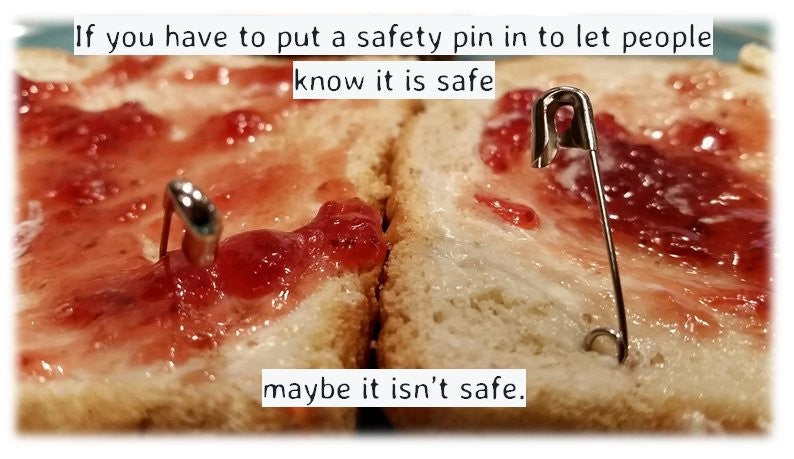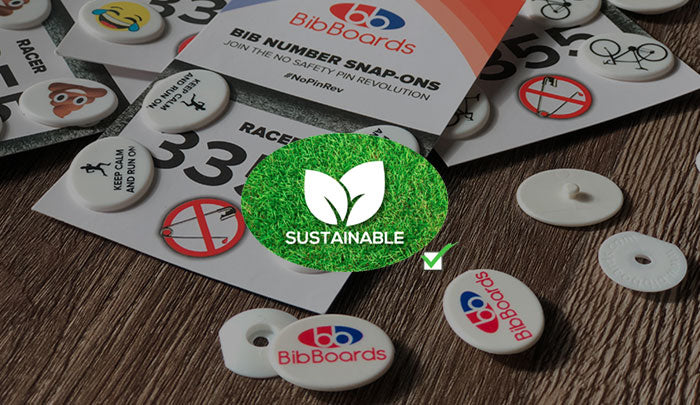Safety pins have a history of utility since their invention in the 1800s. They've been regarded as the go-to item to fasten clothes, secure cloth diapers and in endurance sports, to keep bibs in place. Unfortunately, they aren't doing a great job at keeping the identification markers in place with all the moving and the due to natural elements such as wind, rain and human error. The fact is they aren't efficient in fastening in endurance sports such as marathons, triathlons, and extreme games. What's more, they are prone to rust, unfastening at the oddest times - before and during races. They also prick the skin, causing lacerations and wounds. Lastly, they tend to damage apparel specially made for endurance sports.
Given all these dangerous possibilities, event organizers and participants still use safety pins but do not really want to. That being said, the disadvantage can be damaging to the safety of participants, their properties and the environment. They've become a problem for cities especially in littering the streets pre and post race and spreading rust which Another huge problem with rust is that it is known to encourage the growth of a specific type of bacteria that causes tetanus. Tetanus, can result in death and is not pleasant in any situation. The bacteria move from the rust to the bloodstream when the nail or chair or rusty object breaks the skin.
The Problem With Safety Pins for kids, the disabled or anyone
Safety pins aren't always safe to use. Since these are mass-produced and manufacturing date varies as well as exposure to elements; such as temperature changes, moisture and exposure to air, they develop rust. Unfortunately, if a participant gets prick or wounded by an open pin, then he/she could be exposed to infection. During endurance activities, movements should not be restrained but because bibs get out of place, along with the pins, participants can get injured such as gracing the skin, wounds, and prickings.
Safety pins are coated with different solutions to deter them from easily reacting to exposure to the environment. These chemical solutions or mixtures can trigger allergic reactions and cause other skin conditions.
Aside from that, they also damage the activewear or specially designed athletic clothes, creating holes and tears. Athletes and endurance race enthusiasts more often invest in clothes suited for releasing moisture to keep away from the body - letting perspiration evaporate easily from the fabric as well as maintain coolness. This specially made activewear is not cheap. Most athletes and enthusiasts rely on these type of clothes to increase the level of comfort and performance.
After Event Clean Up
Another issue about safety pins - they are not disposable and can litter the venue since they so small. They become a problem in leaving waste. That's not good especially if the event or activity advocates for environmental conservation. They are left on the ground - soil or paved streets then washed off to drainage and pollute bodies of water.
Snap and Lock Technology event bib fastener replaces the old safety pin
A team of endurance sports enthusiasts and founders of BibBoards came up with a solution for a better, safer and more efficient way to fasten bibs as well as recyclable and reusable to prevent littering the environment with old rusty pins. BibBoards introduced “Snap and Lock Technology” in the endurance events space to fasten bibs with durable nylon plastic clips. They fasten from the outside that connects to the inner layer of clothing. BibBoards were designed to be stable on any movement and won't fall off. Participants, as well as event organizers and sponsors, have the option of these new fasteners - convenient and more comfortable to use as well as better for conserving the environment. They can be used over and over again, from one race to another. They are also great memorabilia and collectibles.
When participating in endurance sports, leave the not safety pins at home and switch to BibBoards, for safety, convenience and to help save the environment.
Given all these dangerous possibilities, event organizers and participants still use safety pins but do not really want to. That being said, the disadvantage can be damaging to the safety of participants, their properties and the environment. They've become a problem for cities especially in littering the streets pre and post race and spreading rust which Another huge problem with rust is that it is known to encourage the growth of a specific type of bacteria that causes tetanus. Tetanus, can result in death and is not pleasant in any situation. The bacteria move from the rust to the bloodstream when the nail or chair or rusty object breaks the skin.
The Problem With Safety Pins for kids, the disabled or anyone
Safety pins aren't always safe to use. Since these are mass-produced and manufacturing date varies as well as exposure to elements; such as temperature changes, moisture and exposure to air, they develop rust. Unfortunately, if a participant gets prick or wounded by an open pin, then he/she could be exposed to infection. During endurance activities, movements should not be restrained but because bibs get out of place, along with the pins, participants can get injured such as gracing the skin, wounds, and prickings.
Safety pins are coated with different solutions to deter them from easily reacting to exposure to the environment. These chemical solutions or mixtures can trigger allergic reactions and cause other skin conditions.
Aside from that, they also damage the activewear or specially designed athletic clothes, creating holes and tears. Athletes and endurance race enthusiasts more often invest in clothes suited for releasing moisture to keep away from the body - letting perspiration evaporate easily from the fabric as well as maintain coolness. This specially made activewear is not cheap. Most athletes and enthusiasts rely on these type of clothes to increase the level of comfort and performance.
After Event Clean Up
Another issue about safety pins - they are not disposable and can litter the venue since they so small. They become a problem in leaving waste. That's not good especially if the event or activity advocates for environmental conservation. They are left on the ground - soil or paved streets then washed off to drainage and pollute bodies of water.
Snap and Lock Technology event bib fastener replaces the old safety pin
A team of endurance sports enthusiasts and founders of BibBoards came up with a solution for a better, safer and more efficient way to fasten bibs as well as recyclable and reusable to prevent littering the environment with old rusty pins. BibBoards introduced “Snap and Lock Technology” in the endurance events space to fasten bibs with durable nylon plastic clips. They fasten from the outside that connects to the inner layer of clothing. BibBoards were designed to be stable on any movement and won't fall off. Participants, as well as event organizers and sponsors, have the option of these new fasteners - convenient and more comfortable to use as well as better for conserving the environment. They can be used over and over again, from one race to another. They are also great memorabilia and collectibles.
When participating in endurance sports, leave the not safety pins at home and switch to BibBoards, for safety, convenience and to help save the environment.




Leave a comment
This site is protected by hCaptcha and the hCaptcha Privacy Policy and Terms of Service apply.